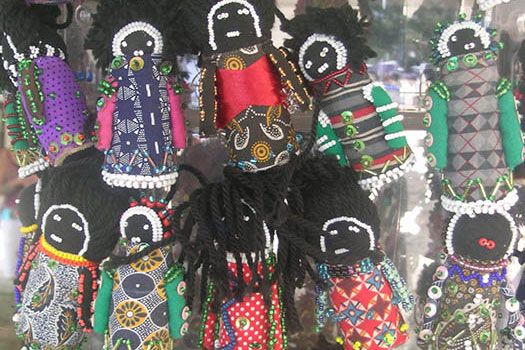Cloth and Bead Children: Unpacking the Orphan Tower

Among the 2012 Smithsonian Folklife Festival’s numerous attractions, perhaps the most globally germane exhibition was the Common Threads tent in the Creativity and Crisis section. Common Threads included several art pieces, all shipped from different regions of South Africa, including work by the Keiskamma Art Project and the Siyazama Project. South Africa has the largest prevalence of HIV/AIDS in the world: a staggering 3.7 million of its residents infected, not to mention the millions of others affected by the pandemic.
The tent was curated in conjunction with The NAMES Project Foundation and the UCLA Art and Global Health Center, and is an extension of their dedication to spreading AIDS awareness and relief. The featured pieces expand the focus of the AIDS pandemic, reemphasizing the global scale of the disease’s desolation and reminding visitors that though ARV treatment has been developed, AIDS persists and remains a pressing issue around the world.
As tourists, D.C. natives, and visitors explored the Common Threads tent, their eyes seemed to fall immediately on the Orphan Tower, a ten-foot high structure of dangling dolls, each artfully and intricately fashioned by South African bead-workers. Children were eager to touch and caress the dolls, which are small enough to fit in the palm of your hand, and parents murmured about how cute they are. When they learned that each doll represents a child orphaned due to AIDS in a single village, their faces fell, suddenly tender with emotion for the doll clasped in their hands.
The Tower, apart from its visually striking and evocative appearance, forced its audiences to face the sheer gravity and scale of the AIDS pandemic, a topic discussed for so many years ad nauseum, resulting perhaps in the banalization of the issue. We can recite the numbers and countries most affected, but as Paul Farmer notes in his book AIDS and Accusation: Haiti and the Geography of Blame, “Knowledge of suffering cannot be conveyed in pure facts and figures, reportings that objectify the suffering of countless persons. The horror is not only its immensity but the faces of the anonymous victims who have little voice, let alone rights, in history.”

Not only is the Orphan Tower a commentary on the anonymity of those impacted by HIV/AIDS, it also provides a physical representation—a tangible demonstration of the pandemic’s toll on a particular population in South Africa—in this case, the large number of orphans in Dannhauser Village.
The faces of the dolls are blank, and but for the different colors of fabric used, they are essentially interchangeable. These small dolls, so numerous and precariously placed on their tower, always vulnerable to tumbling to the ground, inevitably provoked questions; visitors wondered about who takes care of the children, why their parents didn’t survive, whether the orphans too have AIDS.
The Common Threads tent hoped to address these concerns, among others. The curators and artists who worked in this tent were interacting daily with Festival visitors and highlighting issues of access and disclosure, stigma and silence, and the human element behind the horrifying numbers.
Visitors also had to address the difficult problem of how to talk about the Orphan Tower with their children, how to juggle euphemisms and linguistic evasions while trying to give a name to the suffering of the orphans.
It is not an easy thing to speak of, even when we have the words with which to do so, and the visiting women who made the dolls, Lobolile Ximba and Beauty Ndlovu, do not speak English fluently, so they relied heavily on their art to communicate. But these dolls are also gifts, designed with love and care as objects of remembrance to be cherished, as touchstones for empathy and education formed from the subtle weight of memory.
Emma Backe is an intern at the Smithsonian Center for Folklife and Cultural Heritage, where she has been working on the Creativity and Crisis program. She is a rising senior at Vassar College, where she studies anthropology and English literature.

